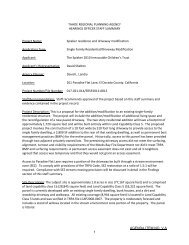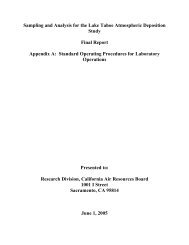FEIS - Tahoe Regional Planning Agency
FEIS - Tahoe Regional Planning Agency
FEIS - Tahoe Regional Planning Agency
Create successful ePaper yourself
Turn your PDF publications into a flip-book with our unique Google optimized e-Paper software.
RESPONSE TO COMMENTS ON THE DEIS<br />
B o u l d e r B a y C o m m u n i t y E n h a n c e m e n t P r o g r a m P r o j e c t E I S<br />
pavers is stated at 50% when other studies and reports assume effective reductions of<br />
70-80%. Green roofs are calculated at a 20% reduction factor. See Appendix AB,<br />
Table 1 for calculations.<br />
Comment 335-q: Comment Summary - If treatment systems are a "test", then this cannot be claimed as<br />
mitigation until monitoring results are available, unless a back up plan is in place.<br />
Comment is noted. The calculations for capture of the 100yr/1hr storm total runoff<br />
volume is reported in the DEIS and support the conclusion that the proposed<br />
stormwater treatment systems will have the capacity to capture, convey and infiltrate<br />
this volume. Post-project monitoring is proposed as part of the Project as standard<br />
practice SP-9 and will be based on the selected Alternative. If TRPA discharge limits<br />
are not met (measured during post-project monitoring), then mitigation measure<br />
HYDRO-1 will apply.<br />
Comment 335-r: Comment Summary - The cumulative impact analysis on water quality, water supply,<br />
and air quality incorrectly finds no impact because projects have to adhere to<br />
standards. Rather the analysis should consider the small, incremental contributions<br />
of all projects to determine if they are cumulative impacts.<br />
Please refer to the cumulative analysis in each section of Chapter 4 of the DEIS. For<br />
some cumulative analyses, the DEIS does conclude that a significant cumulative<br />
impact would not occur because existing regulations prevent a significant impact<br />
from occurring; however, this statement is applied only to those resources that are<br />
protected with regulations that prevent a significant cumulative impact. For example,<br />
impacts related to water supply for the project are limited to water infrastructure for<br />
those projects within IVGID's jurisdiction, which excludes most of the cumulative<br />
projects for the area. Impacts to other water districts will not affect IVGID<br />
operations. Further, water supplies must be secured by each project. A project that<br />
does not secure water supplies cannot be built, thereby eliminating the project from<br />
consideration. In the case of impacts such as water quality, the regulations<br />
established for water quality significantly limit runoff pollutant levels to ensure water<br />
quality is not affected. Often, as is the case with this Project, water quality can<br />
improve with redevelopment and implementation of best management practices and<br />
treatments that improve the existing runoff quality. Since the Project results in<br />
beneficial impacts to water quality and hydrology, it would not contribute to an<br />
adverse cumulative impact. For traffic and air quality, vehicle queuing will actually<br />
improve with Alternative C development; therefore, the Project would not contribute<br />
to a negative cumulative impact, rather, it would help to reduce a cumulative impact.<br />
These conclusions are provided in the cumulative analysis provided in each section<br />
of Chapter 4.<br />
Comment 335-s: Comment Summary - The EIS should consider impacts on lake clarity from N and P<br />
sources.<br />
See Appendix AB, which presents the supplemental water quality analysis and the<br />
predicted reductions in annual loading for Total Nitrogen and Total Phosphorus. See<br />
Tables 2 and 3 and Figures 6a and 6b, which present predicted loading during a wet<br />
water year (e.g. worst case scenario).<br />
Comment 335-t: Comment Summary - Under SP-3, what will be the qualifications required for this<br />
inspector? Given the size of the project area, is one monitor enough?<br />
NPDES permits outline the level of professional training and experience necessary to<br />
complete SWPPP inspections. TRPA can require contractor training and additional<br />
SEPTEMBER 8 , 2010 HAUGE BRUECK ASSOCIATES PAGE 8- 147






